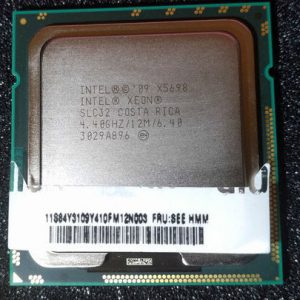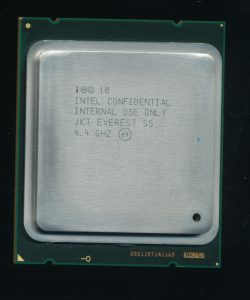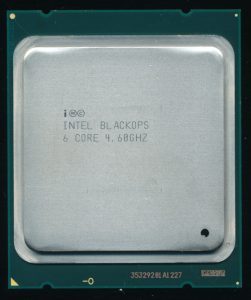CPU of the Day: The Intel Everest Series
Mt. Everest is the tallest mountain here on Earth, the pinnacle of climbing challenges. There is no going higher then Mt. Everest. At Intel the pseudo-unofficial codename for the absolute fastest speed bin of a particular processor is…Everest. Everest processors are the fastest an architecture will so reliably. Sometimes these processors end up an normal products, available for consumers to purchase. The first good example of this is the Core 2 Extreme QX9775 Yorkfield core (Core Architecture). They were a quad-core processor running at 3.2GHz, fast but not mind blazingly so. The Xeon equivalent was the X5492 (Harpertown) 4-core at 3.4GHz.
The next well know Everest was a chip based on the Westmere (shrink of Nehalem) architecture. The Westmere Everest became known as the Xeon X5698, and was available for OEMs only, in fact it was a special order processor made with one particular type of client in mind. These were to be used for High Frequency Stock traders, and other such high speed transactional processing, where the ability to complete trades as fast, and reliability as possible is the entire nature of the business. This means that single thread performance is far more important then having multiple core, and as such, the X5698 uses a 6-core die with only 2 cores active, but retaining access to the entire 12MB of L3 cache. Clock speed was fixed at 4.4GHz, the cores did not reduce frequency as processing demands changed, as this would introduce uncertainty in how fast it would complete a given task. Doing task ‘X’ should take a predictable amount of time and not depend on what speed the processor chose to run at. The next fastest Westmere processor was the X5690, which was a 6-core (all cores enabled) running at 3.46GHz (the same chip essentially as the Core i7 990X). The X5698 was nearly 1GHz faster. The X5690 cost around $1800, where as the X5698 cost around $20,000 EACH (based on costs OEMs charged to add a 2nd one so they may have marked it up some). The impressive thing is that these chips would go faster. Intel sampled 4.66GHz versions and Supermicro built systems using X5698’s overclocked to 4.8GHz. All this back in 2011.
Intel’s next architecture was known as Sandy Bridge. Sandy Bridge topped at at 3.5GHz (6-cores) for the Core i7 Extreme 3970X and 3.6GHz for the 4-core i7-3820 and similar Xeon E5-1620. Intel demo’d an air cooled Sandy Bridge running on stage for a presentation at 4.9GHz, so the core certainly had some room to spare. There is no documentation (that I could find) that Intel actually released anything faster then 3.6GHz, at least that I could find, but evidence suggests that they at least were thinking about it. The picture is a Sandy Bridge Xeon in LGA2011 marked JKT EVEREST SS 4.4GHZ INTERNAL USE ONLY. JKT is short for Jaketown, Intel’s codename for the 32nm Xeon E5-2600 series. That gives a very good idea what this processor was to be. SS is likely to be a Single Socket (as often at those speeds getting dual systems working can be tricky). Sandy was certainly capable of hitting 4.4GHz, with 4-core, and even air cooling, so perhaps these were samples for a limited OEM run, much like the previous Westmere X5698 processors.
After Sandy came Ivy, and once again Intel cranked things up. The fastest Ivy Bridge was the 3.6GHz 6-core i7-4960X and 4-core 3.7GHz i7-4820K. On the Dual-socket Xeon side is the 6C 3.5GHz E5-2643v2 and its 4-core brother the E5-2637v2 at the same speed. SIngle socket Xeons reached 3.7GHz for the E5-1660v2 and 1620v2 (6 and 4 core). This is a marginal gain over Sandy, 200MHz isn’t bad, but knowing Sandy could do
4.4GHz plus why did Intel stop at 3.7GHz with Ivy? Power dissipation is very likely the limit. These parts all dissipate 130-150 Watts, which is about the max of what Intel likes to deal with. Above that and motherboards and PSU’s begin to have issues supplying the processors(s) with enough power, and cooling systems have to be upgraded to remove the heat. It certainly CAN be done though. Intel released a few special Ivy Bridge CPU’s under the name ‘BLACK OPS.’ These are the Everest of Ivy, and were again for OEM use only, and very likely destined again for Wall Street applications. Two versions have been seen, a 4.4GHz 4-Core and a 4.6 Ghz 6-Core. The 4-Core had 25M of L3 Cache which means it most likely was using a 10-Core die (the dies had 2.5ML3 per core) with 6 cores disabled. The 6-core uses the same die and has the same 25ML3. These are spec’d at 250W, meaning without very robust cooling they need to be underclocked to work in a normal system. They also had hyperthreading disabled, something again not needed for raw single thread performance typical of stock trading applications. These are marked like the name implies, no copyright, no normal Intel FPO, just the codename and speed, as if they don’t officially exist. One major difference between these and the Sandy Everest is that these are spec’d as Xeon E5-4600v2’s, meaning they are, at least on paper, rated for quad-socket applications.
The fastest known Haswell is the 4Ghz i7-4790k but as of yet nothing faster is known (its likely Intel made something, just not known yet). The Broadwell series actually saw a reduction in max clock speed, the i7-6850K 6-core running at only 3.8GHz and dissipating 140W (you can see why clock speed had to be lowered as the TDP is higher). Intel did make a special run of Broadwell-EP 14nm CPU’s known loosely as the E5-2602v4 using a 10 core die with 4-cores active. This was rumored to have 10ML3 Cache but it is more likely that it retains the 25M of the 10-core die (like the Black Ops Ivy Bridges). Target frequency on these was 5.1GHz and the rumored customer was the NSA (National Security Agency) which is of no surprise. These were to be rated at 165W TDP which is high, but not unreasonable. As of yet none have been seen in the wild.
Given the lack of information available on Haswell/Broadwell Everest series processors, it is unlikely information will come out on any of the later cores, such as Skylake, Kaby Lake and Coffee Lake for sometime. Some of these CPUs, in single and dual core turbo mode, can push 4.3GHz so it will be interesting what Everest binned devices are capable of. If you have information on other high clocked parts, certainly let us know in the comments.






July 4th, 2018 at 11:20 am
>The fastest known Haswell is the 4Ghz i7-4770k but as of yet nothing faster is known
Not the 4.4 GHz 4790k?
https://ark.intel.com/products/80807
July 4th, 2018 at 12:28 pm
yah meant to type 4790K, but its only 4Ghz, (4.4GHz is only for Turbo)
July 4th, 2019 at 3:07 pm
I can’t see why the N5A would want a ludicrously high-clocked processor. Their supercomputer stuff is all about parallelism. Brute-forcing codes is all about parallelism. You’d be better off with more cores at a lower speed.
That is, assuming code cracking is what they have in mind, but it’s what they use most of their supercomputers for. As far as we know.
December 1st, 2019 at 7:49 am
Ivy Bridge Blackops CPU really goes crazy hot. Water cooling strongly recommended. Also CPU runs at 1.6V so strong X79 board with really robust VRM solution needed. My X79 Deluxe from ASUS just exploded